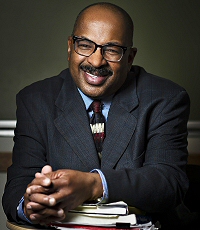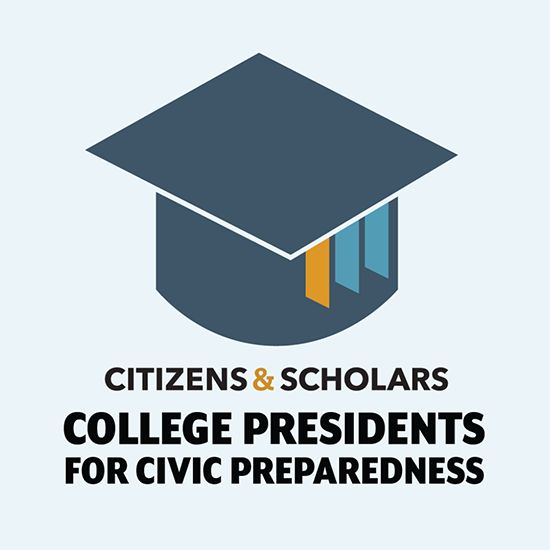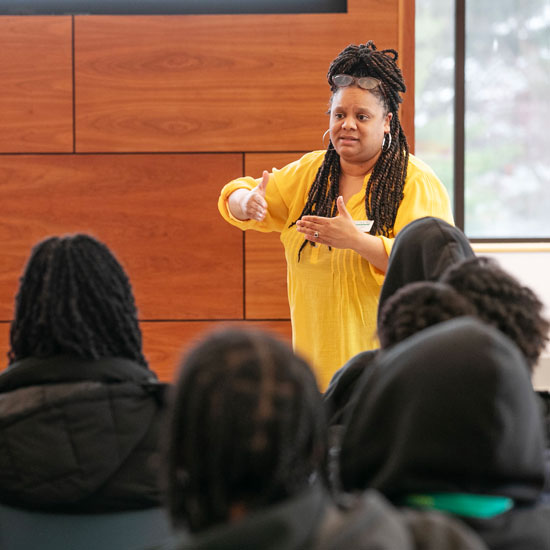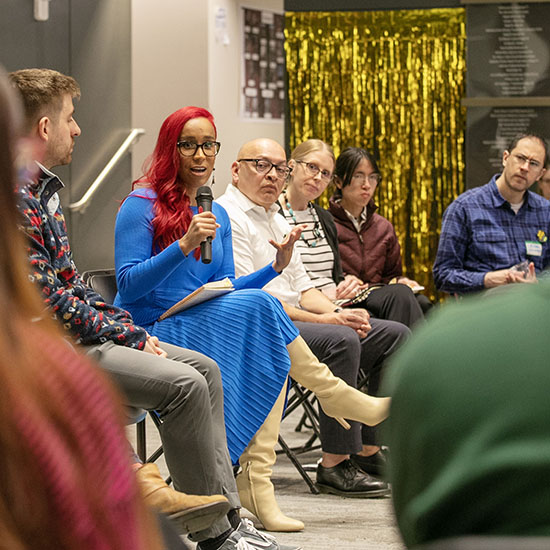Navigating difference
It's the first day of class, and the professor asks his 20-plus students to mill around and shake hands even with classmates they already know. Apart from the social awkwardness, he asks them, what did you notice? Several reply that the style or vigor of the handshakes differed with male and female students.

Tim Harper
Next the students take a questionnaire about seatmates on a long plane flight, asking
them to rank preference criteria such as body shape, race or ethnicity, talkativeness,
attractive appearance, sex and age. The professor predicts, and the students admit
he's right, that almost no one listed race or gender in their top-three criteria.
Yet he reports that many studies—including his own people-watching on trains and planes—show
that race and sex are usually major factors in choosing whom to sit near or whom to
make room for. That, he says, "is a big reason why we need courses like this. We don't
like to admit it, but identity biases can play very strong roles in our interactions."
The course is the 300-level "Social Identity in the Workplace," taught by Tim Harper
in management and business. He says it typically draws about one-third business majors,
one-third business minors, and one-third others.
The course covers academic terminology and theory, but Harper says, "In-groups and
out-groups, privilege, stereotyping, the intersections of identities, the way we turn
on and turn off certain identities in certain situations—these are universal, affecting
our lives every day in big or small ways."
Still, candor about personal identity can be challenging. Up front he tells his students,
"This course will require self-disclosure, not of your intimate feelings, but of your
social feelings." He enlists their help in making the classroom a safe space for such
honesty and openness, "because without it, we won't learn anything new or useful here."
And he predicts the course's insights will apply far beyond the classroom, "to help
you navigate identity issues effectively and, hopefully, to help you help others do
the same."
Steven Henriquez '18 says over time the classroom has grown increasingly comfortable
because "Professor Harper does a great job making everyone feel included and safe
when speaking about sensitive subjects."
Harper employs little bonding rituals. "We try to start each class session with a
few student stories about incidents of identity-related exclusion or inclusion from
their lives, just as a way of sharing with each other. And I try not to end a class
unless each and every student has said something-a comment or story, or maybe a response
to class discussion that they didn't think of at the time." For Henriquez, that sparks
at least as much learning from peers as from the professor: "Helping everyone speak
their mind means the class has different points of view to offer," he says.
Enesa Ososkalo '18 agrees: "The dialogue between classmates has become much more fluid
and comfortable as the course has progressed. Professor Harper keeps an organized
class session but also allows us to talk through the topics."
Harper has learned that "if we're discussing an issue and I notice a student's eyes
get big, there's likely an invisible identity at play." He also knows, "Sometimes
students don't want to self-disclose a lot about these identities, but they almost
always want them to be in our discussion. They feel empowered, if only privately,
to have their identities represented in the classroom."
In one exercise, he and the students count a point for each kind of privilege their
social identity gives them in American society, and they tot up scores on a whiteboard.
Harper says students are sometimes "surprised that even though I'm African-American
I end up with a lot of points—for sex, education, job status. It helps them see all
the different types of privilege that may be operating between any two people."
The mobility of privilege is also on the agenda. When members of a higher-status in-group
join an out-group, they're often seen as bringing their in-group privilege with them,
perhaps boosting the status of the out group. Conversely, in-groups often want newcomers
to assimilate, so as not to bring along any lower status from their former group.
For Harper, "If the stakes are seen as a zero-sum pie, then opening up the in-group
and out-group dynamics could mean losing privilege. But not everything is a pie! Sometimes
there's plenty without surrendering anything. Or in some situations, the benefit may
be worth the loss." He cites research showing that people who try to assimilate or
downplay their group affiliation (Harper cites moderate politicians in either party
these days) "often face a kind of self-isolation; the social costs can be high."
The class next takes up cross-cutting to forge blended groups that break down differences.
Sports fans or teams, for example, can bring together people of different identities.
A crisis or disaster can do the same: differences lose importance as everyone bands
together to survive. But as soon as the game ends or the crisis is over, do people
adopt their accustomed identity attitudes again? Can short-term cross-cutting events
have a lasting effect, or do we all tend to return to our baseline levels of bias?
As they grapple with these issues, Harper says, "I love it when students have an epiphany."
Less dramatically, "once they grasp the theories and dynamics, they have the tools
that can improve their productivity not just in their jobs but also in their family
and community and life." Yoon Young Sim '16, who took the course last year, is already
finding it helpful. "I strongly believe," she says, "that the background knowledge
and real-world issues that we covered in class make it easier for me to deal with
how people think about my identities and to participate in discussions with colleagues."


